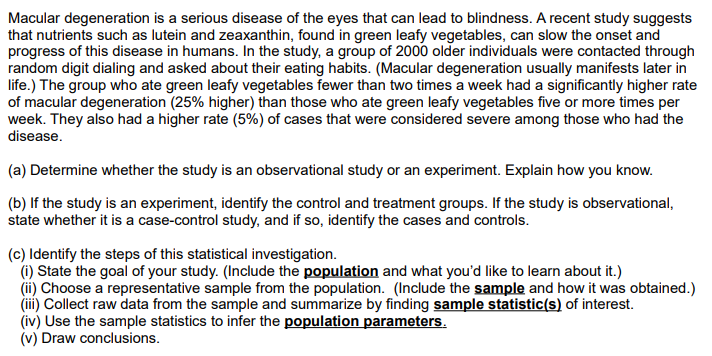than those who ate green leafy vegetables five or more times per week. They also had a higher rate (5%) of cases that were considered severe among those who had the disease. (a) Determine whether the study is an observational study or an experiment. Explain how you know. (b) If the study is an experiment, identify the control and treatment groups. If the study is observational, state whether it is a case-control study, and if so, identify the cases and controls. (c) Identify the steps of this statistical investigation
Macular degeneration is a serious disease of the eyes that can lead to blindness. A recent study suggests
that nutrients such as lutein and zeaxanthin, found in green leafy vegetables, can slow the onset and
progress of this disease in humans. In the study, a group of 2000 older individuals were contacted through
random digit dialing and asked about their eating habits. (Macular degeneration usually manifests later in
life.) The group who ate green leafy vegetables fewer than two times a week had a significantly higher rate
of macular degeneration (25% higher) than those who ate green leafy vegetables five or more times per
week. They also had a higher rate (5%) of cases that were considered severe among those who had the
disease.
(a) Determine whether the study is an observational study or an experiment. Explain how you know.
(b) If the study is an experiment, identify the control and treatment groups. If the study is observational,
state whether it is a case-control study, and if so, identify the cases and controls.
(c) Identify the steps of this statistical investigation.
(i) State the goal of your study. (Include the population and what you’d like to learn about it.)
(ii) Choose a representative sample from the population. (Include the sample and how it was obtained.)
(iii) Collect raw data from the sample and summarize by finding sample statistic(s) of interest.
(iv) Use the sample statistics to infer the population parameters.
(v) Draw conclusions.

Step by step
Solved in 4 steps




